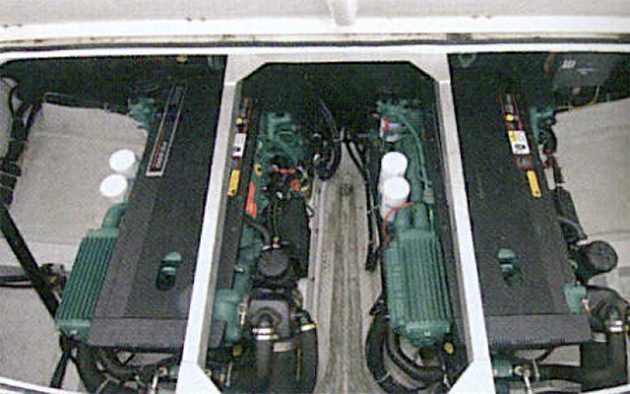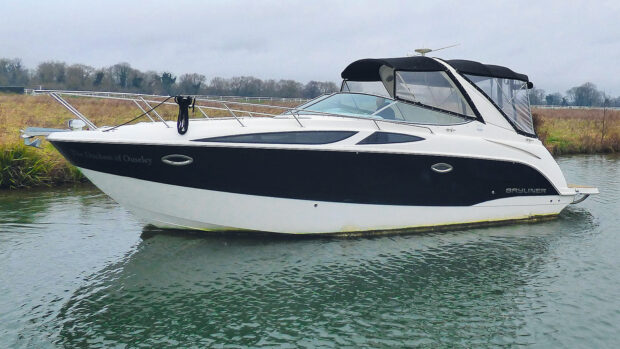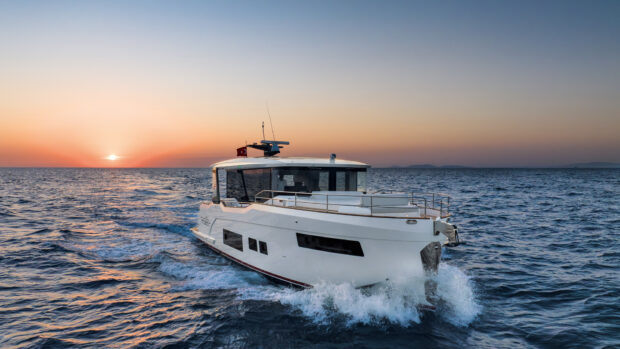After a season of work, pleasure and general pootling, our team reflect on life aboard the Beneteau Flyer 12
It only seems weeks ago that we were picking up our brand-new Flyer 12 from Beneteau dealers Dickies International and already we’re waving goodbye to it.
In fact it was back in May last year that we first clapped eyes on our new steed at the Brighton Boat Show.
Ours was the first Flyer 12 in the country and eager punters were queuing up to experience this handsome new hardtop cruiser with its revolutionary IPS drives and joystick control.
Like us, they wanted to know whether Volvo’s bold claims of massively improved performance, fuel economy, refinement and manoeuvrability stacked up.
We would be able to go one step further and find out whether there were any longer term issues with reliability, servicing costs and resale value.
Nine months and 170 engine hours down the line, we now have all the answers from the many MBY contributors who have skippered her.
Under way
David Marsh – Technical Editor
Most of us think that we’re logical human beings, but we have our irrational twitch points.
Some of us are utterly intractable about the way mooring lines are tied on.
With me, it’s being able to see out safely when I’m under way.
The inaugural delivery trip from Brighton to the boat’s regular home in Shamrock Quay at the top of Southampton Water may not have been particularly intrepid, but it was long enough to review my twitch point.
Our Beneteau Flyer 12 passed with flying colours.

David Marsh found the helm ergonomics good.
The French builders don’t tint their screens – instead, they lightly mirror the side windows and leave the front screens clear.
The single deep wraparound screen arrangement and wafer-thin stainless mullions provide a panoramic view out, only impeded by the unavoidable glassfibre supports at the rear.
Although, erm, restrained in the height department, I still found that the ergonomic triumvirate of comfortable helm seat, wheel and throttles worked just as well for me as it did for the six-footers on the team, either standing or sitting.
However, some rival boats outdo the Flyer 12 with their tilting wheels and adjustable seats with flip-up bolsters.
Under way in the relatively calm water that our passage dished up, the IPS-propelled Beneteau Flyer 12 trims more bow-up than the shaftdrive Antares 12 we tested (MBY June 2005), hardly surprising since the 1,800kg (in total) lPS500s are positioned considerably further aft than the shaftdrive’s 370hp D6s.
However, by crossing the wakes of the numerous tankers that cluttered the north end of the Nab Channel, it was possible to emulate the smooth ride of the Antares by using more trim tab to immerse the fine sections right at the bow.
What this passage did allow us to appreciate was the low level of engine noise and vibration, particularly once the cockpit doors were closed.
On a long passage this is one of the IPS drive’s greatest assets.
Beneteau Flyer 12 performance
Greg Copp – Technical Writer
When you’ve got four 35-tonne sportscruisers bearing down on your stern quarters at 30 knots or more, you need a boat with plenty of grunt and quick steering responses to keep one step ahead of the pack.
This is the somewhat alarming situation I found myself in when skippering the Beneteau Flyer 12 as a photo boat for our group test of 62ft sportscruisers (February 2007).
Thankfully, the Flyer 12 had already impressed me on numerous previous occasions with the seemingly effortless performance of her twin IPS500 drives and she delivered again when I needed it most.

Strong performance and handling of IPS drives came in handy when being chased by four 62-footers.
With MBY snapper Lester McCarthy screaming in my ears to dance back and forth across their bows, she responded faithfully to my every input.
Even close to her maximum top speed of 35 knots, the Flyer was happy to dive into a full-lock turn, letting the computer work out how for to vector each pod.
In less demanding circumstances, she was happy to cruise at up to 29 knots, burning 22gph.
Her shaftdriven sister, the flybridge Beneteau Antares 12, burns nearly 30gph at this speed and only manages 30 knots flat out with the same D6 engines.
Not that it was all plain sailing – halfway through the season we noticed a drop off in our Flyer 12’s performance.
It was only when we lifted her that we discovered the problem.
The bronze alloy legs, which were thought to be fouling resistant, were littered with barnacles.
Once cleaned up and antifouled with a suitable paint, the Beneteau Flyer 12 once again lived up 10 its name.
RYA trainer and MBY contributor Jon Mendez, who skippered Prospector VII during the Try-a-Boat feature at the Southampton boat show, reckoned that she could keep pace with the neighbouring Sunseeker Superhawk 34 all the way up to 30 knots.
Not bad for a ten-tonne cruiser!
Life on board the Beneteau Flyer 12
Rob Peake – News Editor
Early teething problems, a busy diary and I he small matter of a monthly magazine to produce meant that we never managed to undertake any extensive cruising last season.
However, I did get to spend long days and short nights on board in preparation for my Coastal Skipper Completion certificate.
Sleeping on a 40ft sportscruiser rarely feels like The Ritz but there is nothing wrong with the Beneteau Flyer 12’s accommodation.
Berth sizes are good, locker space is acceptable and there is reasonable headroom in both cabins.
It’s not as nicely finished as the best British boats or as cosy as the best Scandinavian ones but it is bright, clean and practical.

Superb saloon – but leave the doors open on a hot day.
The red leather seats and contrasting woodwork in the saloon look particularly smart and the electric sunroof in the hardtop proved to both leak proof and reliable, if a little slow.
However, it’s not without drawbacks.
My first weekend aboard was spent in scorching sunshine and, for a pallid Englishman like me, the area under the hardtop soon started to feel like a mobile greenhouse.
Even with the cockpit doors and small side windows open, ventilation isn’t great and opening the large sunroof simply invites more UV rays in.
Air-con is well worth considering if you plan to keep the boat anywhere hot.
We’d also recommend specifying fixed seating for the aft cockpit.
Our boat didn’t have it and we missed being able to lounge outside and enjoy the feeling of fresh air on our faces.
The two-hob galley is basic but there’s room enough around it to prepare a small meal.
You might find the fridge on the small side for extended cruising duties.
Ease of use
Jon Mendez – RYA Yachtmaster Examiner and MBY contributor
Having been on the boat for over 100 of the 170 hours what I came away with is the sheer ease of use.
Spending eight hours a day at the helm of any boat is tiring.

Jon lets the team know some navigation tips.
Doing it whilst giving a running commentary in a busy Southampton Water, daily safety briefings and berthing in a crowded Try-aBoat zone with hundreds watching at the Southampton Show is especially knackering.
But the Flyer took it all in its stride and the IPS and joystick just made the berthing easy, even on the windy days.
At day end, it was just a quick squirt with the hose to lose the salt, ten seconds with the pledge to keep the wood sparkling, shut the doors and hit the pub. What a boat!
Almost without exception the 750-plus people who came for a blast at Southampton were impressed by the IPS Flyer.
The experienced boaters could not believe how quiet it was.
The way it transmitted the power to the water in acceleration and griptight turns and wake-hoping at 30-plus knots with ten people aboard with absolutely no deviation from the course is seriously impressive.

The crew found it easy to work on deck.
What about the joystick? Well, Gemma, my excellent crew for the show, had never driven a boat before.
After a quick word of explanation, she took it off the berth, round to the River ltchen to refuel and back – up to that point she’d thought I was good!
Just one word of warning: partners suddenly seem very keen to drive, but while sharing your boating is great, never getting another go on the helm is another matter entirely!
JPS Joystick
Sue Goddard – Editorial Assistant
I’m something of a novice boater especially when it comes to low-speed manoeuvring and would rather concede the controls than face the prospect of berthing a boat myself and damaging someone else’s in the process.
However, after some initial training with Jon Mendez on our Beneteau Flyer 12 and first-hand experience of the boat’s IPS system, manoeuvring at low speed using IPS was remarkably straightforward and stress-free.

IPS drives and the magic stick made close-quarters manoeuvring a doddle.
I was amazed to find that I could turn very tightly in the marina using the wheel and one engine at a time much like a sterndrive boat (particularly useful if one engine fails).
Or, I could keep the wheel centred and use ahead and astern like a shaftdrive boat and she would turn around slowly, perfectly controlled, even when reversing.
The joystick controls took a little longer to get used.
On first acquaintance they seem quite aggressive, but once mastered it becomes second nature to stabilise and direct the boat any which way with just a slight movement of finger and thumb.
Running costs/reliability
Hugo Andreae – MBY Editor
It’s all very well the rest of the team blatting around the South Coast in this prime slice of boating real estate but they’re not the ones writing the cheques.
That’s my job and I’m the one who gets his backside tanned if I blow the mag’s boating budget!
The big question was whether the impressive fuel economy of the IPS drives was going to be spoilt by poor reliability or excessive servicing costs.
Our time with the boat did throw up a few teething issues.
When manoeuvring around at low speed the electronic engine controls would sometimes refuse to engage gear on the port engine.

The engine’s diagnostic system set the alarms buzzing on the linked Raymarine E120 display and indicated that a voltage drop on the port engine bank was to blame.
Finding the reason for the drop was much trickier, involving several visits to our local Volvo dealer RK Marine.
They eventually tracked it down to Beneteau’s practice of wiring the electrics to a common earth.
This meant that even though the power-hungry bow thruster fed off its own battery, the sensitive engine management system picked up a drop through the common earth it shared with the port engine batteries and refused to engage gear.

When cruising. the Benteau Flyer 12 burned a reasonable 22gph.
Once the bow thruster was connected to a separate earth, normal service was restored.
As with all the early IPS boats our Flyer 12 was also called in for a free ‘upgrade’.
This involved fitting additional anodes to the transom and inside the IPS exhaust.
At the same time, a corrosion protection primer and a couple of coats of antifouling were applied to the leg and clamp ring.
Newer boats should have already undergone this upgrade prior to commissioning.
With all this work covered under warranty, we were left with just the normal servicing costs for the initial 50-hour service (£460) and the annual/200-hour service (£1, 137).
The IPS legs also had their first-year service (£317), although we were spared the major service due every other year (£881).
This averages out at a whisker under £600 a year for both IPS drives, which still compares favourably with the average annual cost of servicing Volvo’s DPH sterndrives (£815).
A similar sized shaftdrive boat would simply need to have its bearings checked and anodes replaced at a cost of around £325 (all prices quoted are inc VAT).
All this was carried out with exemplary professionalism and remarkably little input from ourselves.
It took a brief call to dealers Dickies and the rest was taken care of.
We aren’t the only ones to be impressed by their professionalism: several of you nominated Dickies for this year’s Service award as well.
In all, the extra cost of servicing the IPS legs are more than offset by the fuel savings we made over running a shaftdrive boat.
Of course this doesn’t take into account the extra initial purchase price of the IPS drives, but then how do you put a value on the superior performance, refinement and low-speed manoeuvrability they bring to the party?
You’ll have to take a view on that one yourself.
Beneteau Flyer 12 verdict
When Dickies told us that they had to put Prospector VII up for sale before we pushed the engine meter past 200 hours, we secretly hoped the cold weather would delay any sale until the start of the new season.
This would allow us to enjoy a few more crisp winter mornings safely ensconced in the warmth of her enclosed saloon.
Unfortunately, we weren’t the only ones to have latched onto the Flyer 12’s all-year-round cruising potential.
Within days of it being offered for sale, Prospector VII was snapped up for close to the asking price of £235,000, answering our final question about the boat’s long-term residual prospects.
The Beneteau Flyer 12, it seems, is still hot property and the IPS drives only add to its appeal. We’re already sorely missing our one.
First published in the April 2007 issue of MBY.
Details
Price from: £235,238 inc UK VAT
Overall length: 41ft 5in (12.62m)
Beam : 13ft 1in (3.99m)
Displacement: 9.3 tonnes (light)
Draught: 3ft 10in (1.16m)
Fuel capacity: 264gal (1.200 litres)
Water capacity: 70gal (320 litres)
Engines: 2 x 370hp Volvo IPS500
RCD category: B (12 people)
Max speed: 35 knots approx
Conatact: www.beneateau.com









